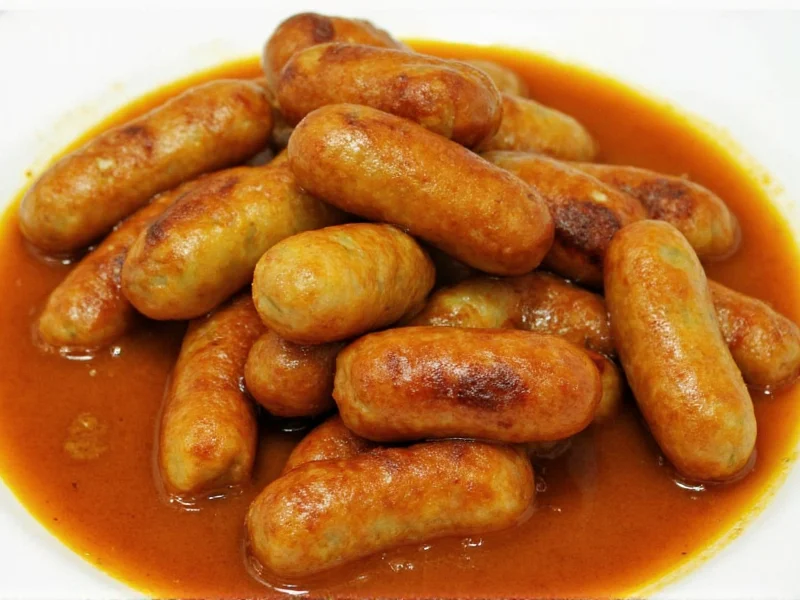Currywurst represents one of Germany's most beloved culinary inventions, blending post-war resourcefulness with international flavor influences. This humble street food has evolved from a simple Berlin snack into a national institution with regional variations that reflect Germany's diverse culinary landscape.
The Historical Origins of Curry Sausages
The story of currywurst begins in post-World War II Berlin. In 1949, Berliner Herta Heuwer reportedly created the first currywurst after receiving ketchup and curry powder from British soldiers. She combined these ingredients with other spices to create the distinctive sauce that would define this German specialty. Heuwer received a patent for her "Chillup" sauce in 1959, cementing currywurst's place in German food history.
Originally sold from food stands in working-class neighborhoods, currywurst quickly spread throughout West Berlin and eventually across Germany. The dish gained particular popularity during the 1950s and 1960s as affordable street food for factory workers and urban dwellers. Today, Germany consumes approximately 800 million currywurst servings annually, with Berlin alone accounting for roughly 70 million.
Traditional Preparation and Key Ingredients
Authentic currywurst preparation follows specific methods that contribute to its distinctive taste and texture. The traditional process involves:
- Selecting the right sausage (typically a pre-cooked pork bratwurst)
- Steaming or boiling the sausage to heat it through
- Optionally slicing or cutting the sausage to increase sauce absorption
- Frying the sausage briefly to create a slightly crisp exterior
- Applying the signature curry sauce generously
The curry sauce represents the heart of this dish. While recipes vary by region and vendor, traditional currywurst sauce contains:
| Core Sauce Ingredients | Common Variations |
|---|---|
| Tomato ketchup | Tomato passata for fresher taste |
| Curry powder | Custom curry blends with turmeric, cumin, coriander |
| Vinegar or lemon juice | Worcestershire sauce for depth |
| Water or broth | Red wine for complexity |
| Sugar | Honey as alternative sweetener |
Regional Variations Across Germany
While Berlin claims the currywurst's origin, different German regions have developed their own interpretations of this classic dish:
- Berlin style: Served with a thinner, more liquid sauce poured generously over sliced sausage, often accompanied by fries
- Rhineland style: Features a thicker sauce with additional spices, typically served with bread rather than fries
- Hamburg style: Includes a distinctive addition of soy sauce to the curry mixture
- Southern Germany: Often uses regional sausages like Nürnberger Rostbratwurst with curry sauce
These regional differences showcase how currywurst has been adapted to local tastes while maintaining its essential character. Food historians note that the sauce's consistency often correlates with climate, with thicker sauces prevailing in cooler northern regions.
Cultural Significance and Modern Adaptations
Currywurst has transcended its humble street food origins to become a cultural symbol. Berlin established a Currywurst Museum in 2003, celebrating the dish's history and cultural impact. The snack has appeared in German films, literature, and political discourse, symbolizing post-war reconstruction and cultural fusion.
Modern adaptations of traditional curry sausages include:
- Vegetarian and vegan alternatives using plant-based sausages
- Gourmet versions with artisanal sausages and house-made sauces
- International fusion interpretations incorporating local spices
- Pre-packaged kits for making authentic currywurst at home
Despite these innovations, the core elements of currywurst remain remarkably consistent. Food anthropologists consider it a prime example of culinary globalization—taking foreign ingredients (curry powder from British soldiers) and transforming them into a distinctly German food tradition.
Creating Authentic Curry Sausages at Home
Home cooks can recreate traditional German currywurst with these professional tips:
- Select high-quality bratwurst with at least 70% meat content for best texture
- Steam rather than boil sausages to preserve flavor and texture
- Create sauce at least 30 minutes before serving to allow flavors to meld
- Use a custom curry blend rather than generic curry powder for authentic taste
- Serve immediately after saucing to prevent sogginess
- Pair with traditional sides like steamed potatoes or fries
For those seeking the most authentic currywurst experience, Berlin food experts recommend using a specific type of German bratwurst called "Brühwurst" and creating a sauce with precisely measured curry powder proportions. The ideal ratio balances sweet, tangy, and spicy elements without overwhelming the sausage's natural flavor.
Frequently Asked Questions
What's the difference between currywurst and regular sausages?
Currywurst specifically refers to a German preparation where a pre-cooked pork sausage is served with a distinctive curry-spiced ketchup sauce. Regular sausages lack this signature sauce and serving style that defines currywurst as a complete dish rather than just a type of sausage.
Can I make vegetarian currywurst at home?
Yes, vegetarian currywurst has become increasingly popular. Many German brands now produce plant-based sausages specifically designed for currywurst. When making vegetarian currywurst at home, use high-quality vegan sausages and ensure your curry sauce contains no animal products, which is typically the case with traditional recipes.
What's the proper way to eat currywurst in Germany?
In Germany, currywurst is traditionally eaten with a small paper tray, wooden skewer, and small paper cup for sauce. Berliners typically slice the sausage before saucing, while Rhinelanders often serve it whole. Most Germans eat it immediately after preparation while the sausage is still warm and the sauce is fresh. Fries or bread often accompany currywurst as side dishes.
How did currywurst become popular outside Germany?
Currywurst gained international popularity through German expatriates, tourism, and cultural exchange. Major cities with German communities often feature authentic currywurst stands. Food festivals and culinary tourism have also contributed to its global spread. In recent years, food trucks specializing in international street foods have introduced currywurst to new audiences worldwide, often adapting it to local tastes while maintaining core elements.











 浙公网安备
33010002000092号
浙公网安备
33010002000092号 浙B2-20120091-4
浙B2-20120091-4